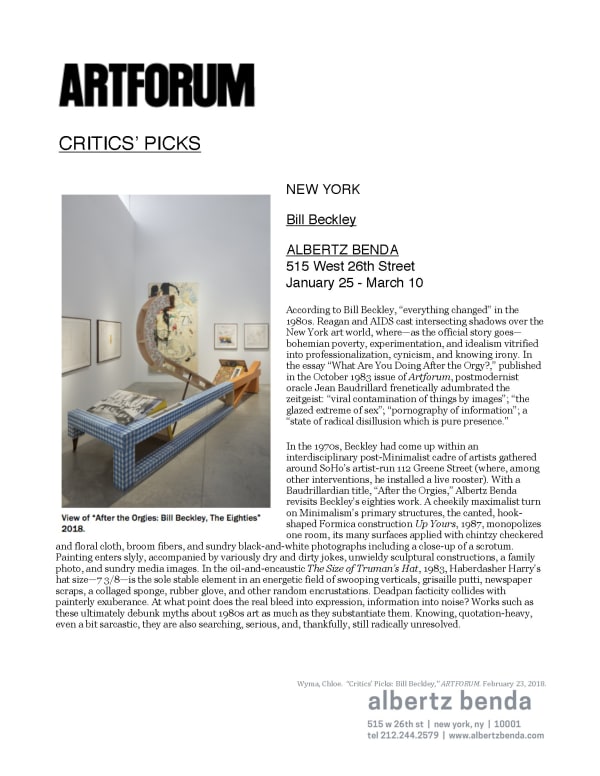After the Orgies: Bill Beckley, The Eighties
“Sometime in 1980, I stood with a friend, sipping chardonnay and watching flesh undulate at a now vintage orgy in SoHo. I remember my friend gazing at the pool of butts and saying, ‘How can it get more liberal than this?’ (It didn’t.)” – Bill Beckley 2017
NEW YORK, NY | albertz benda is pleased to present After the Orgies: Bill Beckley, The Eighties, the artist’s second solo exhibition with the gallery focusing on works from the 1980s, following Albertz Benda’s 2015 inaugural show of early conceptual narrative artworks dating from 1968- 1978. After the Orgies examines the subsequent decade of his work, a period which proved to be highly experimental and emotionally charged for the artist.
Beckley was part of a radical group of young artists based in SoHo at 112 Greene Street, which included Gordon Matta-Clark, Vito Acconci, and Alice Aycock, among others. Eager to cast off the restrictive aesthetics of Formalism, Beckley broke down boundaries between traditional media formats and emerged on the international art scene in the 1970’s as a major exponent of Narrative Art, a term that he invented. He exhibited his typed fictions and glossy photographic surfaces of erotic content, nature, and popular imagery in solo shows at key galleries from Rudolf Zwirner in Cologne, to Yvon Lambert and Daniel Templon in Paris and Hans Mayer in Dusseldorf, and a solo show in the Projects room of the Museum of Modern Art. During this period, Beckley’s work was included in the Venice Biennale (1976), Documenta 6 (1977), and the Whitney Biennial (1979).
Beginning in the 1980s, Beckley underwent a period of introspection and experimentation, branching into painting and reexamining his practice of sculptural constructions. While the 70’s Narrative works engage senses beyond sight through evocative language and color photographs, the wall pieces from the 1980s are immersive, incorporating elements of texture, sound, and monumental scale.
In works such as Front Porch (1987), Beckley assembles a nexus of personal and public histories. Employing household materials ranging from potted plants, furniture, and fabrics from his proletarian upbringing in Pennsylvania alongside photographs of significant American presidents, revered architecture, and popular music, the artist captures a cacophony of memories and sensations that weave narratives of domesticity and civic life. Throughout the 1980’s, Beckley’s sculptural works were shown in galleries such as Tony Shafrazi and Annina Nosei in New York, ACE Gallery in Los Angeles and Galerie Hans Mayer in Düsseldorf.
Further challenging the expressive limits of traditional media, Beckley delved into painting. The pieces are created on canvas and incorporate encaustic, oil paint, collage, and wood trim, rejecting spontaneous gestural composition and overt figuration, instead drawing out a narrative from onomatopoeic wordplay and literary and biblical references. A series of oval-shaped canvases (1986) allude to the plagues of Egypt, while Score Card (1984) establishes an imaginary scoring system for real sexual acts, contrasting snippets of lewd language with images of high fashion models. The highly personal nature of painting presents a new manner of storytelling for Beckley. After the Orgies represents the first time many of these works are being shown publicly.
ABOUT BILL BECKLEY
Born in 1946 in Hamburg, Pennsylvania, a small farming town in the Amish countryside, Bill Beckley attended college at Kutztown University from 1964 to 1968 and in 1970 received a Master of Fine Arts from Tyler School of Art, Temple University. There he studied with Italo Scanga, who introduced him to former students and friends, including Bruce Nauman, Dan Flavin, Sol LeWitt, and Marcia Tucker, then a curator at the Whitney Museum. Thanks to Marcia Tucker, his work was included in Art in the Mind (1969), the first conceptual art exhibition in the United States.
Moving to New York City from Philadelphia in 1970, Beckley was one of the artists (along with Gordon Matta Clark, Rafi Ferrer, Barry Le Va, Jeffery Lew, Bill Bollinger, and Alan Saret) who organized the first exhibition of the legendary gallery 112 Greene Street Workshop in SoHo in October 1970. With his color photographs and references to advertising images, he influenced artists of the so-called Picture Generation like Richard Prince and Jeff Koons, who encountered Beckley’s work during his 1978 solo exhibition of color photographs in the Projects Room at the Museum of Modern Art.
Beckley’s works have been exhibited widely both in the US and internationally, including exhibitions at the Museum of Modern Art, the Solomon R. Guggenheim Museum, the International Center for Photography, the Whitney Biennial (1979), and in Europe at Documenta (1976), the Paris Biennale (1973) and the Venice Biennale (1975). Recent exhibitions include a 2008 show of works from 1971–73, among them his Silent Ping Pong Tables and Short Stories for Popsicles (both 1971), at Chelsea Space (London) in conjunction with the Tate gallery (2009); a 2010 retrospective exhibition titled Etcetera at the Tony Shafrazi Gallery in New York; and a 2011 solo exhibition at Sammlung Hoffmann, Berlin, Germany. In 2016, his large-scale narrative work was included in the UNLIMITED sector of Art Basel, curated by Gianni Jetzer. His work is currently featured in the exhibition Narrative Art at the Musée d’art moderne et contemporain de Saint-Etienne, FR curated by Alexandre Quoi.
Beckley’s work is in the permanent collections of museums worldwide, including: The Museum of Modern Art, New York; Whitney Museum of American Art; Solomon R. Guggenheim Museum; Smithsonian American Art Museum; Museum of Fine Arts, Boston; Tate Modern, London; Daimler Collection, Stuttgart; Sammlung Hoffman, Berlin; and in numerous private collections including the Morton Neumann Family, Jeff Koons, and Sol LeWitt











